I had left Tok and headed to Fairbanks. I needed to make time so I rarely stopped to shoot photos but as I was riding through the landscape here, which continued to be beautiful, it dawned on me that I have not often mentioned the horror show that's been unfolding on my helment and bike.

Ever since I got into British Columbia, the bugs have just been horrific. I remember the mosquitos from the '92 trip, but this is much different. These beasts are HUGE. I don't know what kind of bugs they are but some leave truly nastly large green splotches. My Transit Suit is covered with them as is the bike. When they hit my helmet, it's such an impact that I can feel it through the padding. In addition, there seems to be an explosion in the dragon fly population. I have never hit a dragon fly before but now I'm hitting them left and right. These are not your average little dragon flies. These are beasts. When they hit the leathers I feel it as if it were a small stone. Yuck. It's going to take forever to clean this mess up.
The bugs are a constant. But after a while you just get used to it, so used to it that you forget to mention it.
At a gas station I saw one of the only older BMW's I've seen on the trip. This styles is called an "air head". They stopped making them in the '80s, but I think this one probably dates back to the late '70s. Bruce has one, an R100RS.
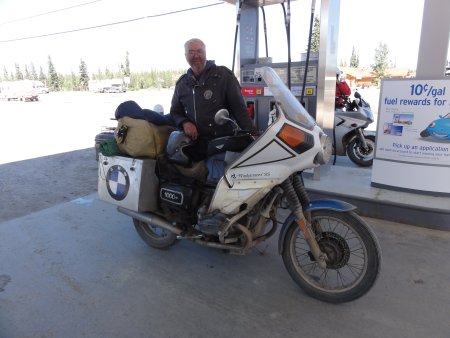
"Have you seen one of these before?", he said as he pointed to a patch on his jacket. He had his BMW 1,000,000 Mile patch. "Yea, but it's been a while.", I replied. I thought about that momentary exhange for some days to come. "Status symbol", I thought, "not one that I would ever want to have.". Riding used to be about numbers to me. How many miles did you do today? How far have you gone? Always numbers. Numbers don't mean much to me anymore. I haven't checked how far I've travelled. Is it 7000 or 8000 miles? More? Less? I don't know and I don't really care.
I saw more moose along the way.
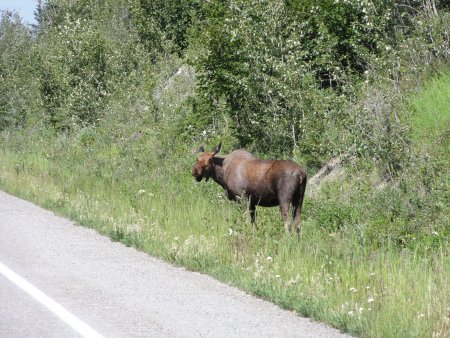
I had stayed in a Super 8 Motel with WIFI, which took FOREVER to find. I had wanted to catch up on the blog since I hadn't written any posts in a few days.
It was hot in Fairbanks, really hot. Somehow the sun in Alaska is brighter and hotter than it is elsewhere. You can feel it immediately when you walk outside, even late at night. It burns. I imagine it's a small hint of what radiation burns must feel like. It's intense. I was hot and very unhappy about it. The Transit Suit does not do well in slow traffic in the heat. You just cook.
The next day I got up early because I wanted to make it to Camp Coldfoot on the Dalton. I had expensive reservations at the "motel" for Friday and Sunday, and a separate reservation at the Caribou Inn in Deadhorse. So I had to keep a schedule. Rooms book up quickly in both locations and given I didn't know what the Dalton Highway was going to be like I didn't want to press my luck by camping. I needed a good nights sleep. The reservations were non-refundable.
The section of the Dalton Highway from Camp Coldfoot to Deadhorse is 240 miles of nothing. No services, no stops, no nothing. My bike can just barely do 240 miles on a tank so I didn't want to push it. After some searching around I finally found a store that had some smallish gas cans. I could have chosen the one gallon can but I thought I should carry a bit more in case I encounter an out of gas rider. I would have plenty to spare.

With the empty can bungied down I headed out of town. Once you get north of Fairbanks things start getting remote very quickly. It wasn't too many miles up the road to the Dalton before I started seeing heavy equipment being hauled.

Big machinery.
I had heard about grading repair construction on the Dalton which involved a grader evening out piles of material on the road. I was surprised to run into a section of road where this was being done well in advance of getting to the Dalton.
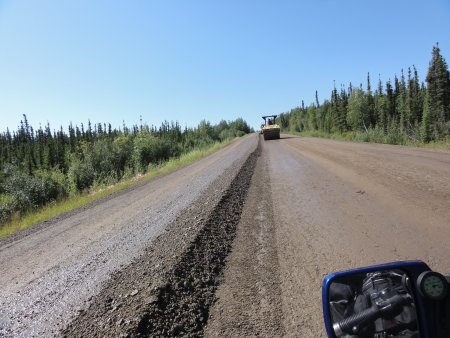
The mound of material was too high for me to cross. "This could become a real problem if I needed to jump sides quickly.", I wondered as I considered the roads ahead. When they do this work, they also wet the road making it slippery. The front and rear wheels slip and slide a bit. If you have no off-road experience this can be rather disconcerting. It was of no concern to me. The bike went in the general direction I wanted it to. "The Dalton is said to be much worse", I thought.
I came upon an overlook and wanted to take a photo. The scenery was spectacular as it has been for ages now, but I'm still not tired of it. I rolled left, came to a stop and when I wanted to move forward I let out the clutch but nothing happened. The clutch lever was loose and it would not engage. It felt as if the clutch cable had just broken.
I examined the clutch lever and could see that the cable was still, for the first 1/2 inch of lever travel, pulling the lever, but it would stop. "Hmmm, the clutch cable must finally be stuck." I got off the bike, took off my gloves, helmet and removed my ear plugs. It was hot in the direct sun. I played with the clutch lever some more and heard a clunking sound.
"Now this could get interesting.", I said outloud with zen like calm as I considered that the most likely explanation for the clunking sound was that my clutch had just disintegrated basically putting an immediate end to my trip.
I was calm. As a matter of fact, I was surprised to realize, as I stood there on the side of the road out in the middle of No Where with a broken motorcycle that Would Not Go, that I had no emotional reaction to this event at all. I started to imagine what would happen. I considered starting to tear the bike down right there. Maybe I could patch something together. I thought about how long I would have to wait. I checked the cellphone. Yup, no signal. I played with the lever some more confirming that an ugly sound was emanating from below. I thought about inconvenient fortuitous interruptions. "$600 in hotel reservations gone.", I realized. Oh well.
If this had been during the Nightmare where everything on earth would go wrong all the time, I would have had a strong emotional reaction. I would have felt that this breakdown was somehow my fault. It would have confirmed my worst fears about myself. The fact that my machine let me down would have brought back memories of being told "you're a failure", so many times. I would have found some reason to tie this event to my own self worth. It would have devastated me inside. Only those who know me the best could tell when this happened.
But today, Away, I was calm. In a strange way I was looking forward to the consequences. I could let Deadhorse go. "Deadhorse is an arbitrary excuse for a Journey. Maybe this new journey will be more interesting.". I poked around the lever. Yup. Let the lever go, and it only moves about 1/2 inch leaving the rest of the travel useless. Put the bike in gear, let the lever go, yup. Nothing. Bike No Go. I thought maybe if I engaged and disengaged the lever and thus the partially actuating clutch, maybe it would collapse enough to let me ride off in first. I kept hearing the clunking sound from underneath. "Before I jump to conclusions, let me investigate. I tend to jump to the worst possible conclusion and while most often it's been the correct one, maybe this time is different.". I played with the clutch some more, all the while frying in the intense blazing Alaskan Sun. "That's funny. I left the clutch lever out abruptly and the clunking noise I hear is coming from the exhaust." I began to imagine catastrophic internal engine damage, but realized I couldn't come up with a scenario that made any sense where the clutch self destructing would affect the exhaust. I looked underneath the bike. The clutch cable connects to a lever that is parallel with the exhaust on the rear of the engine. There's alot of mud down there. I reached up, pulled and let the clutch lever go. I could see the lower level raise and lower and heard the clunking sound.
"Now look at that.", I actually said aloud.
A rock had lodged itself exactly between the lower lever and the exhaust. When I let the clutch lever out the lower lever was hitting the rock and would move no further, thus not engaging the clutch. I pulled out my trusty Victorinox Swisstool and five minutes later I had a working clutch. I snapped a photo of the spot where this happened.
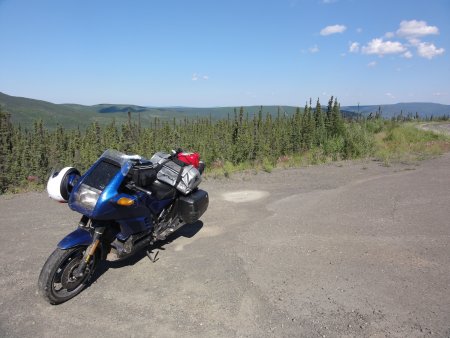
"There's a lesson here.", I pondered as I was finally able to feel a breeze again.
Some time later I came upon the start of the Dalton Highway.

This road is somewhat of a legend made famous by the show Ice Road Truckers. The legend was magnified in my mind by the seemingly countless riders I met along the way that told me, in essence, that I was crazy to ride this road. "Even with an adventure bike running knobby tires I wouldn't ride that road. It's the most hellish road on earth.", they would say.
I wondered what I was going to find. I imagined a road like the impassable trails I had followed in Missouri. I imagined stones the size of the ones on the firetrail in Telluride. I thought about the times I got my dirtbike stuck in two feet of watery mud. I had said to the Netjets pilot, "It's a slog if you have to get out a shovel.". I wondered how many times would I have to get the shovel out.
I also was interested to see what modifications had been done to the tractor trailers and RV's and other vehicles that drive this road to allow them to pass "the most hellish road on earth.".
Clearly I wasn't thinking it through very clearly.
I didn't have to wait long to see what it was like. Within 500 feet the pavement ended. "So much for it being paved to the Arctic Circle.", I thought.

"Heavy industrial traffic", it said. Great. I had heard of baseball sized gravel being kicked up and killing 10 riders at a time. Well, not really. I had heard people had gotten injured by baseball sized gravel being kicked up as tractor trailers passed. I was looking forward to seeing some of this gravel. "Baseball sized? How do they drive on that?".I would be disappointed. I got hit by a cherry sized piece of gravel once. It bounced off the leathers without ill effect.
The next clue I ignored, still being full enthralled by the legend of how difficult this road is supposed to be.
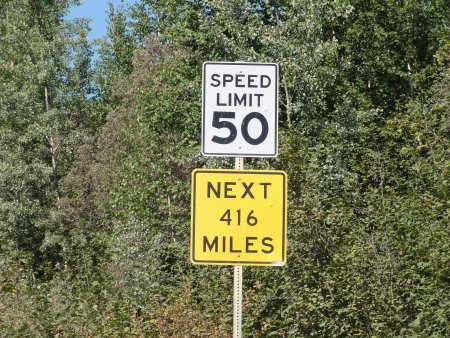
"50mph? These must be some World Rally Championship truck drivers.", I thought. 50mph on rutted wet mud roads? Are they kidding.
"This should be interesting."
I had read about the calcium chloride they use to bind gravel together. What I did not realize is it creates a surface that approximates pavement. It's a bit crumbly on top with some loose gravel and dust, but on the whole it's not as bad as riding your average farm dirt road. It's much harder and you can carry speed on it. The bike doesn't track quite as linearly as it does on pavement but the squirreliness is easy to deal with. Keeping up a speed of 50mph is no problem on this stuff.
It was early still and I only had 175 miles to go. I was making really good time but I was keeping the speed around the limit. I had that sense that conditions could change any any moment. I had heard the road north of Coldfoot is much worse than the road south of it.
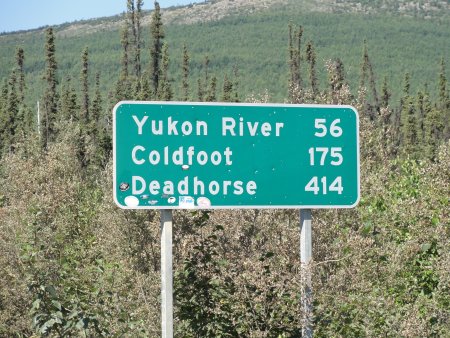
The road continued on. The landscape was green and rolling. It didn't vary much however. Mile after mile it mostly looked the same. The quality of the road changed little in the first 50 miles or so.
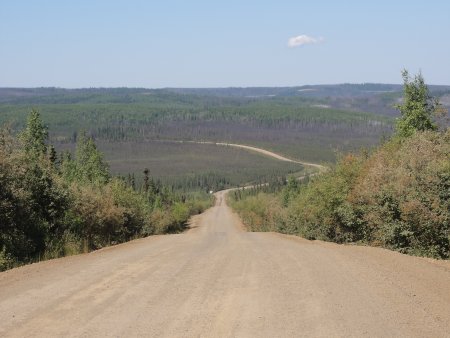
I was beginning to think this was being too easy as I approached a section where they were working on the road. They were adding some gravel which was being graded. As had been described to me, they first put down a mound of the stuff and then run a grader over it. The mounds are pretty high and I would have been hard pressed to cross them with my bike. I think I could probably have done it but try it often enough and I would eventually fall over.
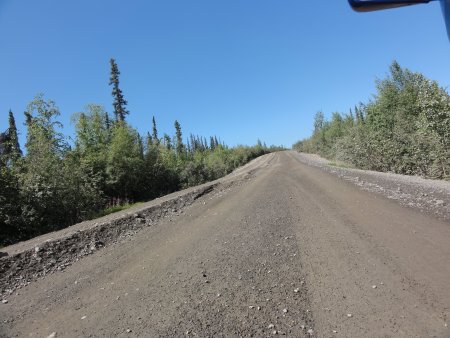
Then just as I was beginning to believe the stories of pavement were tall tales, paved sections appeared. This was not a good thing. The paved sections lulled you into a false sense of security. They would go from perfect pavement, to bouncy, jarring nightmarishly pothole filled sections one second to the next. But it was all still entirely manageable until ...
I was coming up a paved hill that had a sharp left hand sweeper up ahead. I was doing about 60mph. A tractor trailer throwing up alot of dust was coming down the hill towards the sweeper. I watched as the tractor and trailer slid laterally from the left lane into my lane as he came around the corner throwing up even more dust. He recovered as if he had done this 1000 times, but the meaning didn't dawn on me until too late.
DEEP GRAVEL!!!
I hit the corner doing about 50mph only to realize it was about 3" of uneven gravel. There were furrows and mounds of it in all kinds of haphazard patterns. I struggled to keep the bike going in more of less the right direction while shaving off speed. Just as I thought I was going to lose it I gained control of the bike and slipped and slid my way over the uneven terrain up the hill. It lasted less than 100 yards.
It wasn't that bad. It just caught me off guard. At 50mph it's undoable on my bike. At 25 to 30 it was just fine.
And therein lies the danger of the Dalton Highway. Conditions change instantaneously but it happens so infrequently that it easily catches you by surprise. It would be another 400 miles before I ran into another spot of deep gravel. It caught me by surprise too, but the outcome was the same. An elevated heart rate and increased vigilance.
I pondered how I was riding and thought how I should pay more attention. But, contrary to common wisdom, it's unwise to exert that kind of effort. Fatigue is the enemy. If you strain too much watching for particular hazards you become target fixated on them, miss other hazards and you waste a tremendous amount of energy in the process. "I've been riding like this for 35 years and it's served me well. I'll just continue and trust that I'll be able to handle what comes.". I am a very careful rider, but I am not over cautious. Surprises happen. I could have done the road at 15mph and the hazard would have been tractor trailers from behind, which, in my humble opinion, is much more dangerous.
As I pondered how easy the road was in comparison to what I had been told, I came across a dreaded "new wet calcium chloride" section. I had seen bikes covered in mud from top to bottom. I had heard stories of how this stuff clogs radiators and can stop wheels from spinning.

What I didn't realize was how sticky this stuff was. Within about 100 yards my bike already looked as bad as some of those riders I had seen. Then I understood. They too had only gone through a little bit of the stuff. It was a mud-like wet mixture about 2 or 3 inches deep. I had to keep the speed under 30mph and even then it would slip and slide as the tires tried to redirect me into every rut and fissure in the road. It was tricky riding. It also only lasted about a mile. My bike and I were covered in this thick cement like mud.
I now looked like I had been on the Dalton. "Well, that wasn't all that.", I thought.
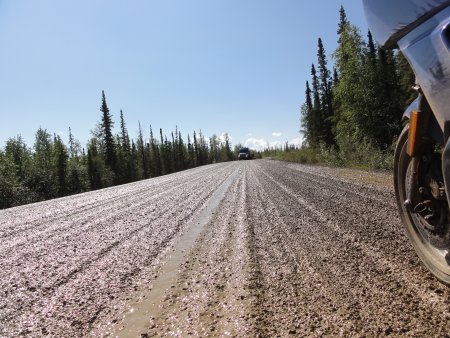
Then I happened upon a bicyclist. She was also doing a charity ride. At first I understood her to say she was going from Prudhoe to Florida, but it looks like she's going to a place called Palmer. Her name is Caren Cioppa. Her charity page is at http://pages.teamintraining.org/wa/bigwilds10/habataku. I promised her I would link to it.
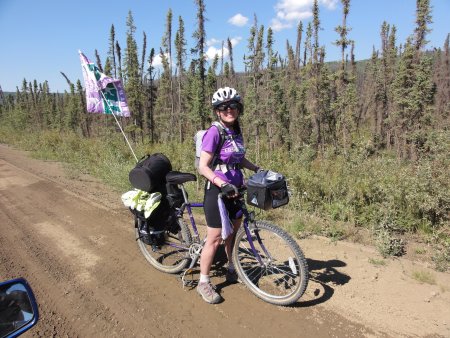
The lower Dalton runs through rolling hills covered with shrub like trees.


Every once in a great while you would see another rider, on a BMW GS of course. Actually, there was the occasional KLR and KTM. I saw no other sport touring bikes though.
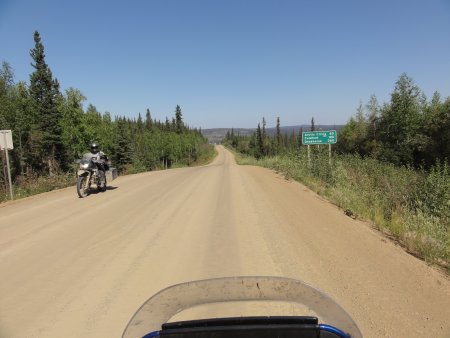
I came upon the Yukon River Bridge. It's made of wood!
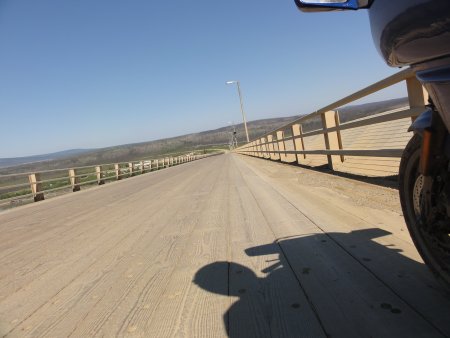
The Yukon River is a good sized river.
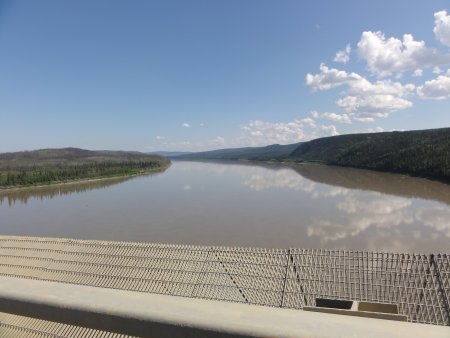
I stopped and got gas the Yukon River Camp. The worst surfaces I've ridden on in this trip have been the parking lots of the various "camps" along the way. Actually they matched what I feared the Dalton would be. Rutted. Irregular. Deep potholes.
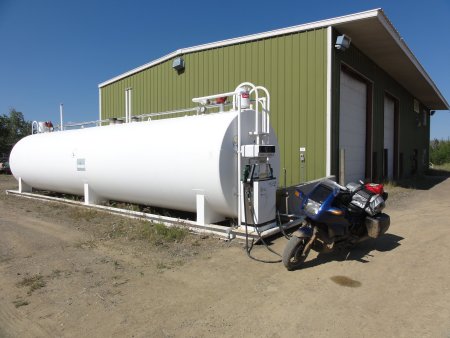
In this part of the world you get a strange appreciation for fuel. You are keenly aware of it. I think it's in part due to the fact that fuel tanks are above ground but also because fuel is so rare here and running out is a real possibility. It takes a truly awe inspiring amount of fuel to enable modern life out here.
And it's expensive.

Another sight you don't see normally is planes parked by the road. This plane clearly uses the Dalton as a runway.
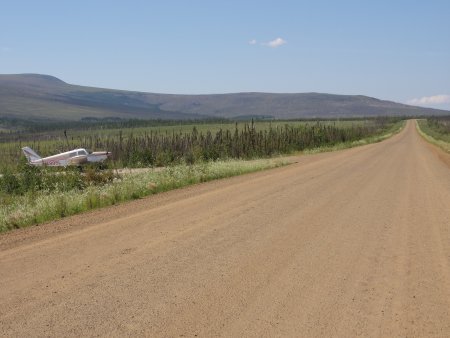
The Dalton Highway follows the Alaskan Pipeline all the way up to Prudhoe Bay.
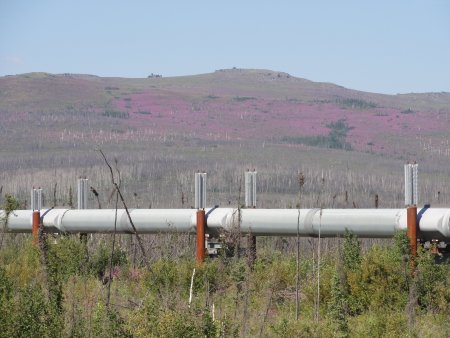
As I mentioned the scenery between Fairbanks and Coldfoot Camp really doesn't change all that much.
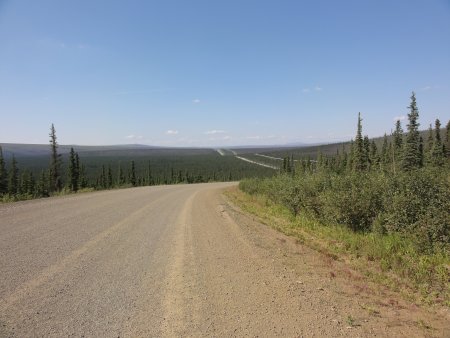
Eventually it starts getting a bit hilly.

About 60 miles before you reach Coldfoot Camp, you cross the Arctic Circle. 18 years ago we had intended on reaching this point. We did a hell ride across the country with the intention of reaching this point on a tight schedule. We did between 750 and 950 miles a day for days on end. By the time I reached Washington State my health gave out and I had to withdraw from the ride. Duncan stayed behind with me. The other two went on to reach the Arctic Circle.
It was a strange reflective moment standing at the circle thinking about the intervening 18 years and everything that transpired; everything I sacrificed or lost.
I was standing there when a Suburban drove up and three women got out. They offered to take a photo for me.
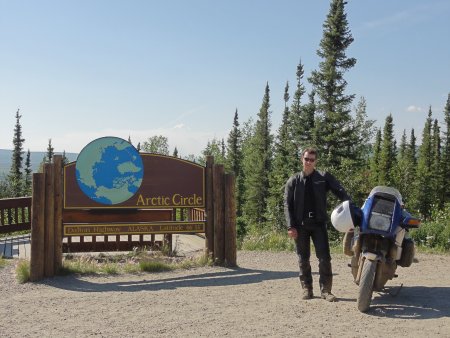
I didn't get their names but my impression was it was a mother, daughter and friend trio. The mother wanted to have her photo taken on my bike. So I moved it around so it was at a better angle and helped her aboard. She seemed to get a kick out of it.
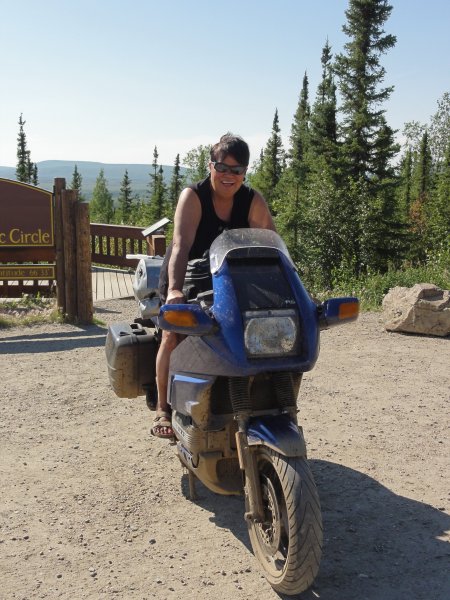
Their Suburban was covered in dust and mud.

They were really nice. The daughter took one look at me and then compassionately offered me a large bottle of water. "You must be hot." They offered me food as well. Also touchingly thoughtful. I didn't have the heart to tell them about the Illness and that I couldn't have sandwiches or that I was allergic to cherries. I was grateful for the water though.
After a little while two GS riders arrived, Rob and Wayne. As it would turn out, we would run into each other multiple times all the way up to Deadhorse. They are business partners who run a heating company. I told them "Too bad Anatoly doesn't ride. That's so cool of you guys to do together." Their business is apparently doing extremely well. At least somebody's is.

Slowly the scenery began to become more interesting.
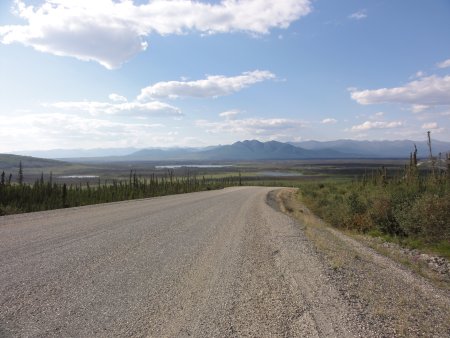
I arrived at the "motel" in Camp Coldfoot in the early evening. The sun never set. I stayed at the Inn. It was basically temporary housing turned into a makeshift lodging facility. It was not quite as nice as the Deal's Gap resort, but it served it's purpose.
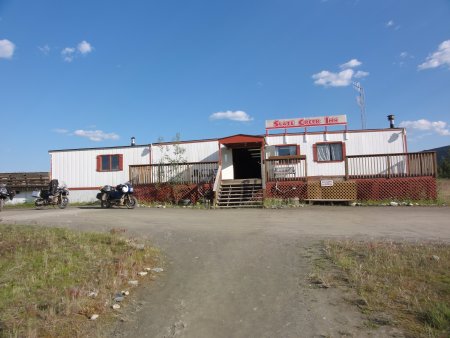

My bike wasn't too bad off. All in all the road from the beginning of the Dalton Highway up to Coldfoot camp did not live up to it's reputation.

I am currently in Deadhorse. I arrived around 4pm today. I have to get up at 6am tomorrow to make it to breakfast in time so I can go on the Prudhoe Bay tour. As a result I won't be able to finish up the Coldfoot to Deadhorse entry until after I get back to Fairbanks. There's no WIFI in Coldfoot.
Even all the way up to Deadhorse, the difficulty of this road has been so oversold as to be an outright exaggeration. The road itself is not difficult. I can see how it would be much more challenging in the rain, but even then my impression is, based on the wet sections I went through today, that it would still be entirely doable. There's always the risk that one might encounter the odd heap of construction gravel or tag the side of a rut the wrong way and go down. But nothing that I saw today in any way matched the kinds of horror stories that people had told me about.
So I spent quite some time thinking about where these stories come from. Experiences are, after all, subjective.
When I observe a behavior that I do not understand, instead of dismissing it out of a hand, I try very hard to imagine a set of circumstances in which I would exhibit the same behavior. I'm the one who looks at a homeless person and asks "what can happen to me today to cause me to be like him tomorrow". I always come up with plausible answers which keeps me humbler than most would suspect. This "the Dalton Highway is hell" scenario is no different.
The Dalton Highway is challenging in places, but not because it's difficult. There's nothing "difficult" about it. It's just long. It does require attention. Fatigue is the real problem. Hazards appear randomly after long periods of monotonous road conditions. Even I fell trap to lowering my guard after the 50th mile of perfect pavement or hardpack. Potholes in pavement can do serious damage. Some potholes can be a foot across and 8" deep. But potholes are relatively rare. Most of the pavement is very good.
The hardpack does tend of have a layer of light gravel and dust on it which causes your wheels to wander a bit. If you are not used to riding in the dirt or gravel this can be disconcerting. It is, however, not a problem. The muddy sections can be a bit challenging but are entirely doable, even on street tires. The wandering is much more pronounced and on the Michelin street tires I have, this is exaggerated. In addition, as your tires find the edges of ruts they tend to move in way that pitches the bike violently making you feel as if it's going to drop. However, there really isn't any need in my opinion to run knobby tires on this road. I think I could do this road in the same conditions as today on racing slicks. If it were raining I might change my opinion. And I may yet have the opportunity to.
So I thought long and hard about all these horror stories. Did those riders just have no experience? Two guys I talked to had been riding almost as long as I have. One said he had extensive hard core offroad experience.
Then I remember a Woman's pool match I watched on television some years ago. If I remember correctly, it was a championship match between the reigning champion and an unlikely upstart that had made her way to the finals. This was causing alot of commotion.
I enjoy the game of pool and it's one of the few competitions that I'll watch on the television when I get a chance.
It was also the only time an announcer has said something that made me pause and think.
It was the upstarts turn. She was making one jaw dropping shot after the next. Her shooting style was impressive and dramatic. She was pulling off shots that I could only do 1 in 10 times on my best night and she was doing them time and time again. But she would eventually miss a shot and the champion would have her turn.
In contrast she seemed only to do easy shots. Each shot was a straight line beginners shot like I could do 95 times out of a100. I didn't really think about it until the announcer said:
"Now that's the difference between championship material and the rest."
I thought he was commenting on the challenger and how good she was shooting.
"A champion makes her job easy intentionally. She plans ahead to make her life easy so she can reserve her best shots only when she needs them. In contrast, the challenger has to pull out her best shot each time and she'll eventually miss.".
Sure enough, she lost the match.
That comment has stuck with me. The Champion won because she put all her work in preparing for the shot, so that when it was done she was set up for the next easy shot.
I thought back to the comments the guys who said the Dalton was 'orrible made. Each one of them had a schedule. "I had to be up and back in two days.". Each went fast. "I was doing 70mph through most of it.".
And then it hit me. Each and every person who said the Dalton was a horrible road attempted to ride the Dalton on their own terms and on a tight schedule. They attempted to ride a partially improved road with random hazards the same way they ride a highway. They were going to ride this road pulling out their best shots at each corner and through each hazard.
They did not give this road the time or respect it needs to be done safely or well. They didn't make things easy for themselves.
While we worked on my boat, Lance once said "You have to give problems the time they need. If you try to force something quickly, bad things happen.".
I imagined not taking my time. I imagined having my self worth and identity tied up in how quickly I could ride up this road and back again. I imagined wanting to brag to my imaginary friends about how cool or tough I was that I could do the Dalton in a Paris-Dakar style.
And I think that is why I had a wonderful relatively peaceful ride and enjoyed the scenery and was unfazed by this road. Seriously, it's an easy road with some hazards that requires attention but is in no way difficult. I had no schedule. If things went badly I was willing to turn around. I was willing to camp. I was willing to push the bike through bad parts if need be. If it rained I was willing to let each section take all day, or longer. I was humbly willing to give the road it's due and as a result it was easy. Strangely, I had no ego tied up in this endeavor. I didn't need to go fast. I didn't need to do it quickly. But I also think that I have had the experience of taking vehicles, including my K100RS, through some truly difficult risky roads. So I did not approach the Dalton from a highway mentality. I approached it from an offroad travelling mentality and not a racing one.
What I enjoyed most, actually, was sitting in the cafes talking to other riders. I met Christopher, Greg and Mike in Coldfoot and had dinner with them. The next morning I happened to be up when they were leaving, because I couldn't sleep, and sat down and chatted with them for a while. Travelling is about stories, not miles or numbers.
For me it's about letting go the deterministic and letting chaos direct me. And I think therein lies another difference.
As a kid I was always fascinated by the game of pinball. Here you have a game where your inputs are so restricted. You have two flippers. The ball can do whatever chaotic thing it's going to do. If you attempt to control the ball deterministically, you lose. It won't do what you demand of it and instead will go down the chute every time. But if you let go. If you work with the game on it's terms knowing full well the that your inputs are limited to "influence", not "control", counterintuitively you can keep the ball in play for a long time.
It is similar thing when driving or riding off road vehicles or piloting a boat. It's less about control and more about influence. Once you let go the deterministic and embrace the chaotic with humility and patience you find you can enjoy them much more and be more successful than someone who attempts to force the machines, and thereby the road, to work on their terms. The latter tends to cause Bad Things to happen.
I have been thinking alot about the parallels between riding a motorcycle and human relationships. Yes, my mind actually does work like that. I believe I've begun to understand that when it comes to people, and especially those relationships most important to me, I do not do what I intuitively do when I ride or pilot a boat. Human relationships are not deterministic. They are chaotic. They have their own terms, just like the Dalton Highway. They are not difficult, but when forced Bad Things happen and they can appear difficult. I have always felts that if only I could teach better, influence better, control better I could be more good to those who I care about.
And in that, I believe I may have been making the same mistake that those unfortunate riders who try to force the Dalton make. I have not humbly embraced with patience my lack of control, my limited influence and just "let go" and accepted these relationships on their own terms. As a result Bad Things happened time and time again and I did not understand.
And for that, I am truly sorry.
 MikeS15 years ago
MikeS15 years agoCongratulations on making it to Deadhorse. You're halfway home.
The difficulty of the journey is relative to your experience. The fact the you found the road to be oversold also shows how well you did in preparing yourself (and you gear) for the trip. Yermo15 years ago
Yermo15 years agoThanks. I think a big part of it is also that I didn't impose any preconceptions on the road. A big part of this is mental. How much patience can one bring to bear. It's an easy road, but it is dangerous and can surprise you.
 Ian15 years ago
Ian15 years agoHalfway home? Yermo, have you considered continuing west? Get a ride over the water and ride west to, say..., Germany.
 Ian15 years ago
Ian15 years agoSeriously, though - I'm happy for you that you made it to Deadhorse. It may have been for No Reason At All and didn't mean everything, but it means something. Come back through Victoria and I'll buy you a celebratory drink.
 pobatra15 years ago
pobatra15 years agoA bit harrowing there with the clutch. This is the best post of all. Congratulations!
 Yermo15 years ago
Yermo15 years ago@Ian don't tempt me. Points far further away have started calling to me. I've met and further heard of a number of people who have done the Prudhoe, pronouned Proodhoo, Bay to Argentina Tierra Del Fuego run ....
@pobata Thanks! Yea, the clutch thing was kind of a pain, but it was foreshadowing. More on that in the next post once I have a chance to write it.
@Ian I will definitely stop by on my way back down. It was suggested that I got to Valdez so I'm strongly considering heading out that way. You're supposed to be able to see a glacier from the road .. and there's a reportedly a boat tour that goes out to a glacier on the water.
Tags
- 56 deadhorse2010
- 21 Lower_48_Out
- 10 Canada_Across
- 9 Canada_Up
- 8 Prep
- 7 Lower_48_Back
- 4 Dalton_Highway
- 2 Alaska
Archives
- 63 2010

You must be a member of this group to post comments.
Please see the top of the page to join.